Site menu:

June 2012 Newsletter
Three Magical Spring Days.
Weather and Migration Study.
May Bird News.
Forthcoming Events.
Latest Newsletter.
Three Magical Spring Days

Like many other birders I had written
off this
year's spring migration, it was getting near the end of April and the
weather had just been so poor we had seen little in the way of birds
passing through. But somebody wiser than myself said "there's plenty of
time yet" - how right he was!
May 2nd was an outstanding day, particularly on Hilbre. Members of the Observatory knew something amazing was going on when they counted 72 Wheatears in the Marine Lake car park at West Kirby on the way over to the island, but this was nothing to what awaited them. I quote Matt Thomas (from 'From the Muddy Banks of the Dee' Blog), who was the Ranger on duty that day: "Looking around it was as if a Wheatear bomb had gone off. All along the west side of the island were Wheatears. Some loafing on the grass, others scromping grubs from the sandy cliffs. If you got one in the viewfinder of the camera there was almost always another in the same frame. There must have been around two hundred of them during the course of the day but their numbers were dwarfed by the amount of Willow Warblers that fell from the skies. Final total was 800. You looked at every bush, fence post and there was a Willow Warbler there. I walked out of the garden of the Bird Obs and nearly trod on one. I have never seen anything like it before."
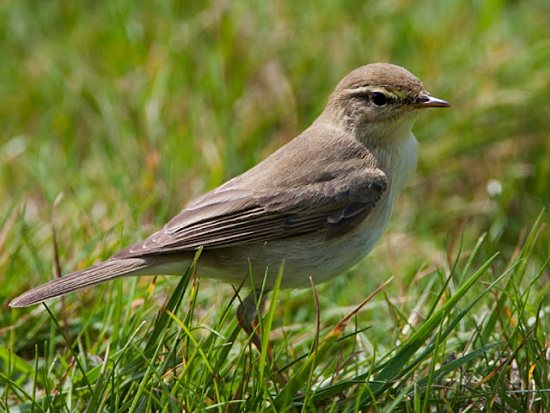
"Hopping so close I had to retreat to fit it all in the frame of the camera".
But what caused this huge fall of birds? Steve Williams' article below on the weather pattern that day demonstrates just how important the weather is during migration. Such big falls are rare events in our area but something similar did occur on April 23rd 1998 when 275 Wheatear and 1,355 Willow Warblers were counted at Red Rocks and adjacent area, among many other birds there were also 95 White Wagtail, five Pied Flycatchers and six Ring Ouzels that day.

This year's migration was certainly
late and much of it was concentrated in those three days - April 30th
to May 2nd. It was particularly good for Willow Warblers, Wheatears,
Whinchats and, as can be seen in the graph above, Common Redstarts. The
graph below demonstrates how late the migration was compared to last
year, which was also good for this species, and also just how many
passed through in those three days with a total of 19 records (as shown
by the green bar).
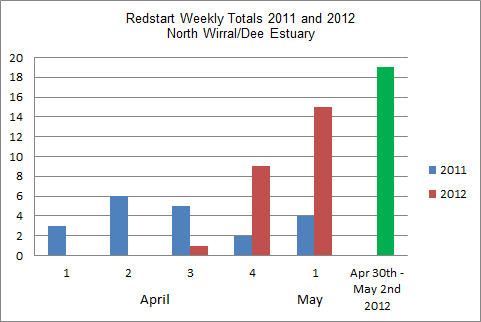
1. Matt Thomas - 'From
the Muddy Banks of the Dee' Blog.
2. Hilbre Bird Observatory Blog - http://www.hilbrebirdobs.blogspot.com/.
3. Jane Turner's Red Rocks records as published in Bird
Forum.
4. My own records and those passed on to me with many thanks.
Weather and Migration Study
This short article by Steve Williams was written on May 2nd 2012, it was published on the Hilbre Bird Observatory Blog that day and kindly reproduced here with permission of the author.
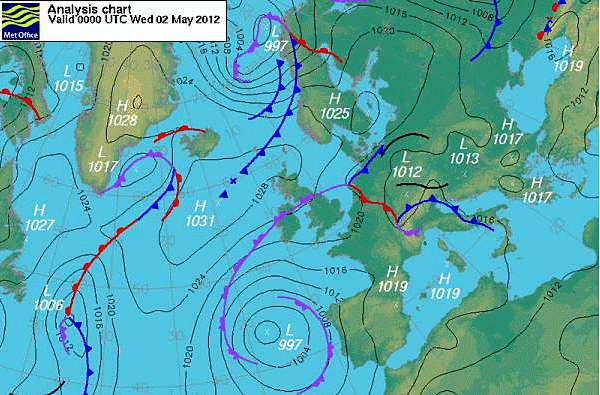
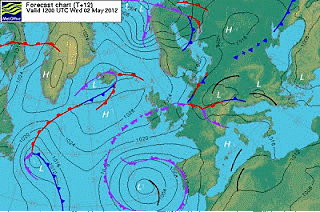
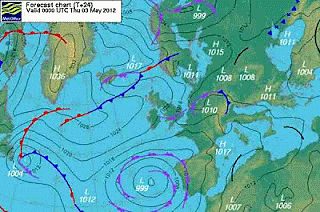
As always we continue to study the weather - which is always easier with hindsight!
Steve Williams
Top of Page
May Bird News
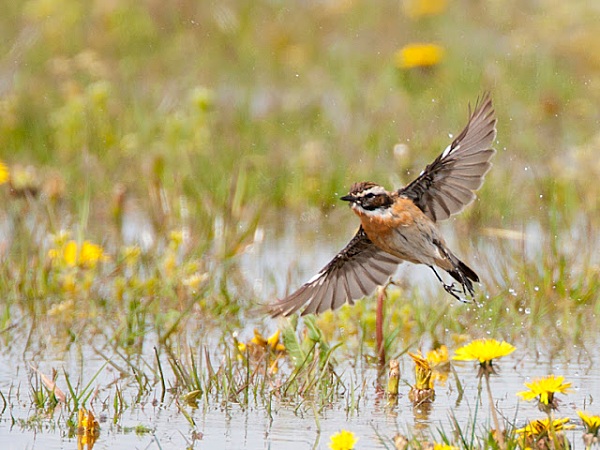
see 'From the Muddy Banks of the Dee' Blog.
After a couple of easterly and southerly gales towards the end of April we knew conditions were right for some interesting birds, the first one duly turned up on the 2nd with a Temminck's Stint at Burton Mere Wetlands, it was presumably the same bird which was on Donkey Stand flash, Parkgate, from the 4th to 7th. This is the first record for this species in the Dee Estuary area since May 12th 2004. There next followed a Black-winged Pratincole on the 3rd and 4th, also at Burton Mere Wetlands. This was a real 'mega' and only the fourth one to be seen in the whole of the UK over the past ten years. A Golden Oriole was spotted in flight at Leasowe Lighthouse by a couple of 'lighthouse regulars' on the 18th, it appeared to go into a line of Willow trees but was never seen again - they are so well camouflaged that they are almost impossible to see once they go into a tree.
Other rare birds included an overflying Dotterel at West Kirby and a Roseate Tern on the sand at Leasowe Lighthouse, both on the 20th. A Turtle Dove was a good find at Red Rocks on the 25th. Both the long-staying Spoonbill and Great White Egret were seen, the former was last recorded on the 7th whereas the latter appeared intermittently all month. The second half of the month saw a total of 10 Red Kite records, probably a record high for the area. There appeared to be at least one wandering bird over Wirral plus probably an additional two seen just the once over Flint.

Spring passage remained strong until the third week of the month and even as late as the 18th there were 20 Wheatears at Leasowe Lighthouse. We had given up the idea of seeing/hearing any Wood Warblers this spring when two late birds turned up with one at Stapledon Wood and the other near Leasowe Gunsite, both on the 23rd. The 26th saw a massive movement of Swifts with several thousand at Red Rocks (3,200 were actually counted but true number could have been double that) and 2,100 over Hilbre on the same date.
Cuckoos are now scarce in our area but it was a comparatively good year with 13 records this month, compared to the more usual six or seven we have seen or heard over the past few May's. There were plenty of Spotted Flycatchers passing through including six at Red Rocks on the 27th. 14 records of Short-eared Owls was a surprisingly high number for so late in the spring, with one or two birds seemingly resident at Leasowe Lighthouse and Red Rocks, and one or two seen from Hilbre, this compares to a total of just two records in May last year.
After several very poor breeding seasons for Avocet at Inner Marsh Farm it is great to see them doing well at the new RSPB Burton Mere Wetlands Reserve which has an electric fence to keep out predators, I understand by the end of the month there were 33 chicks with one or two nests still to hatch. Also at the reserve were a Curlew Sandpiper (non-breeding plumage) and seven Little Stints, both on the 26th.
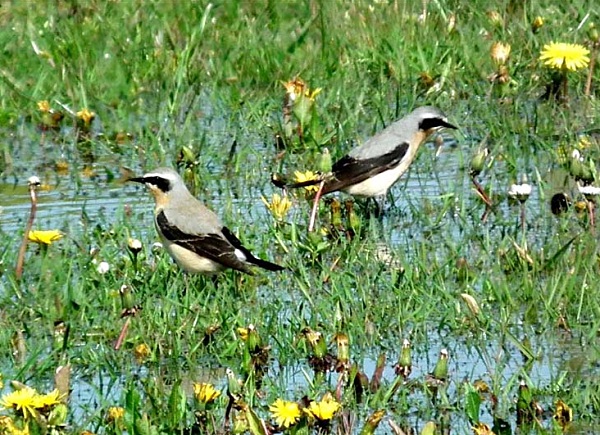
What to expect in June
Early in the month you can still see waders hurrying through on their way north to breed, particularly Ringed Plover (tundra race) and Sanderling, and by the end of the month the first post-breeding waders arrive back. Spotted Redshanks are the first to arrive followed by one or two Green Sandpipers, and we usually get an early Greenshank by month-end. Look out also for non-breeding over-summering birds such as Knot which sometimes can be present in their thousands. There are also breeding waders with a few Ringed plovers, Redshanks and Oystercatchers, as well as the Avocets at Burton Mere Wetlands.
The Little Tern colony at Gronant should be thriving and out to sea will be Gannets and Scoters, and a strong westerly should blow in Manx Shearwaters and Arctic Skuas. It is not too early for the first Sandwich Terns to return, perhaps failed or non-breeding birds.
Raptors will include one or two Hobbies plus the possibility of wandering Ospreys or Red Kites. Most years we seem to get a visit from at least two Spoonbills and it will be interesting to see if we see a Great White Egret or not, perhaps the one that was here for most of the winter!
Forthcoming Events
June Highest Spring Tides (Liverpool)
Also
see Tides
page.
5th June, 12.24hrs (BST), 9.5m.
6th June, 13.15hrs (BST), 9.5m.
Forthcoming Events
Organised by the Wirral
Ranger Service , Flintshire Countryside Service and/or the
RSPB:
All these events and walks have bird interest, even those not
advertised specifically for birdwatching. No need to book for these
events unless specified - please check below.
Also see 2012 Events Diary.
Sunday 3rd June, Garden Wildlife Weekend at Burton Mere Wetlands RSPB,
10 am to 4pm.
Pop along anytime to get free, friendly advice from the
experts on gardening for wildlife.
Be inspired by how the reserve has been set up and even take home a few
plants to help you get started.
Children can get their hands on some wildflower seeds and enter our
grow a sunflower competition.
For further details phone 0151 353 8478 or 0151 336 7681.
Saturday 9th June, Dusk Chorus - RSPB Event, 8pm to 10pm.
Dawn Chorus too early? Then perhaps our first ever Dusk Chorus event is
for you?
Many
birds continue to sing and some become even more active. With a bit of
luck we may even see some of the creatures of the night...... Owls?
Bats? Badgers?
Meet at Burton Mere
Wetlands Car Park.
Cost: Adults - £2 RSPB members, £5 non-members, Children - Free
Wildlife Explorer members, £1 non-members.
Booking essential so please call 0151 353 8478 or 0151 336 7681.
Tuesday 12th June, 1:30pm - 3:00pm, Summer Walk over
Stapledon Woods and Caldy Hill.
Discover the variety of wildflowers and other wildlife on this stroll
with the Ranger.
Meet Kings Drive North off Column Road.
Sorry no dogs/
No need to book.
For further enquiries ring 0151 677 7594.
Saturday 23rd June, 10am to 12 noon, Moth Morning at
Burton Mere
Wetlands.
NATIONAL INSECT WEEK
With an abundance of vegetation Burton Mere Wetlands is an amazing
place for moths.
Our
volunteer moth trappers will be working hard overnight so that come the
morning a whole variety of moth species will be on display and you can
ask our experts as many questions as you like.
Feel free to drop in at any point during the morning.
Children's activities will be running all day in the visitor building.
NB In event of bad weather expect fewer moths!
This event is FREE, for more details ring 0151 353 8478 or 0151 336
7681.
Sunday 24th June, 11am - 1pm. Dragons and Damsels, Part of
Springwatch with the RSPB.
Price: £2 members, £5 non-members.
Booking essential.
The RSPB’s Burton Mere Wetlands is a fantastic place for dragon and
damselflies.
If these mini-beasts enthral you then come along and help us to find
the elegant yet elusive red-eyed damselfly.
We
will scour Burton Mere and the ditches around the reserve in order the
find as many flying insects as possible - we may even see some birds
too!
Stay behind afterwards for a chat and a cuppa.
Children's activities will be running throughout the day.
NB
In case of extreme weather these events may be cancelled.
Bring
your binoculars for close up views. Stout, waterproof
footwear is
advised.
Please phone as booking
is essential, ring 0151 353 8478 or 0151 336 7681.
Friday 29th June, 9:00pm - 11:00pm, Bat and Owl Night at
Royden Park.
Discover the variety of bats and owls that use Royden Park in these
dark hours.
Sorry no dogs.
Warm and waterproof clothing required.
Maximum no. of 18.
Booking essential, please ring 0151 648 4371.
CANCELLED
- Sunday 1st July, 11am - 1pm, Bee-urton Mere Wetlands - Guided Walk